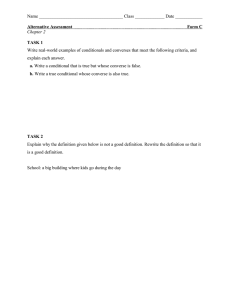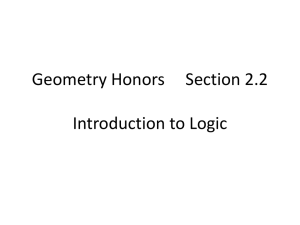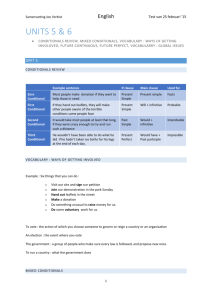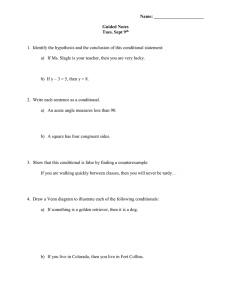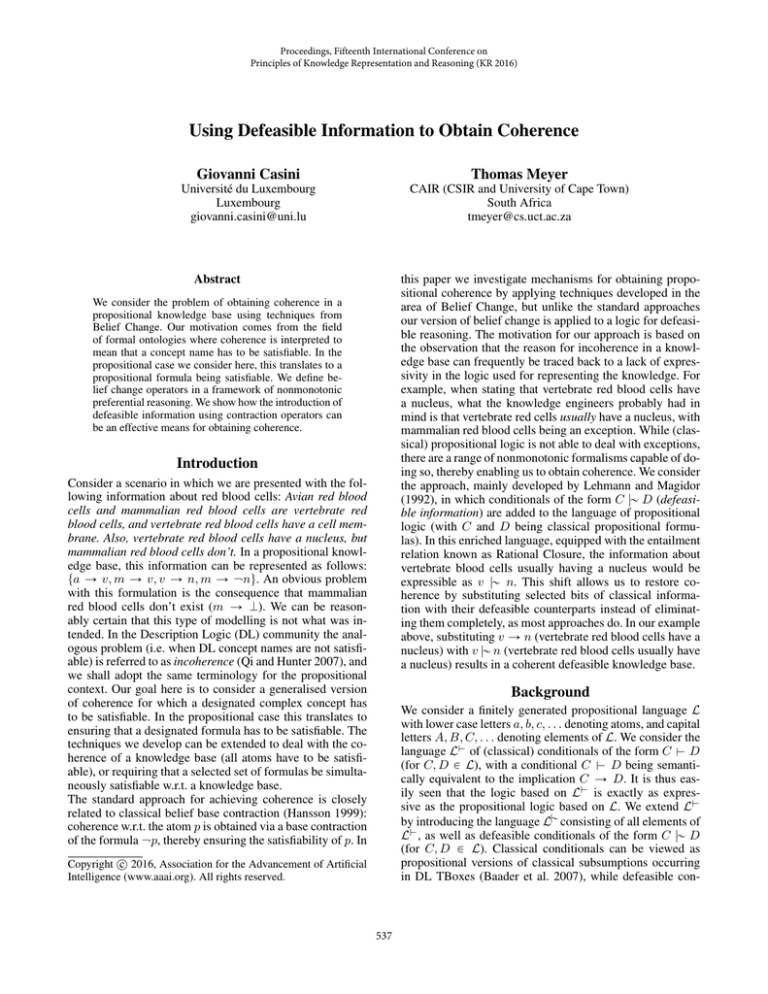
Proceedings, Fifteenth International Conference on
Principles of Knowledge Representation and Reasoning (KR 2016)
Using Defeasible Information to Obtain Coherence
Giovanni Casini
Thomas Meyer
Université du Luxembourg
Luxembourg
giovanni.casini@uni.lu
CAIR (CSIR and University of Cape Town)
South Africa
tmeyer@cs.uct.ac.za
this paper we investigate mechanisms for obtaining propositional coherence by applying techniques developed in the
area of Belief Change, but unlike the standard approaches
our version of belief change is applied to a logic for defeasible reasoning. The motivation for our approach is based on
the observation that the reason for incoherence in a knowledge base can frequently be traced back to a lack of expressivity in the logic used for representing the knowledge. For
example, when stating that vertebrate red blood cells have
a nucleus, what the knowledge engineers probably had in
mind is that vertebrate red cells usually have a nucleus, with
mammalian red blood cells being an exception. While (classical) propositional logic is not able to deal with exceptions,
there are a range of nonmonotonic formalisms capable of doing so, thereby enabling us to obtain coherence. We consider
the approach, mainly developed by Lehmann and Magidor
(1992), in which conditionals of the form C |„ D (defeasible information) are added to the language of propositional
logic (with C and D being classical propositional formulas). In this enriched language, equipped with the entailment
relation known as Rational Closure, the information about
vertebrate blood cells usually having a nucleus would be
expressible as v |„ n. This shift allows us to restore coherence by substituting selected bits of classical information with their defeasible counterparts instead of eliminating them completely, as most approaches do. In our example
above, substituting v Ñ n (vertebrate red blood cells have a
nucleus) with v |„ n (vertebrate red blood cells usually have
a nucleus) results in a coherent defeasible knowledge base.
Abstract
We consider the problem of obtaining coherence in a
propositional knowledge base using techniques from
Belief Change. Our motivation comes from the field
of formal ontologies where coherence is interpreted to
mean that a concept name has to be satisfiable. In the
propositional case we consider here, this translates to a
propositional formula being satisfiable. We define belief change operators in a framework of nonmonotonic
preferential reasoning. We show how the introduction of
defeasible information using contraction operators can
be an effective means for obtaining coherence.
Introduction
Consider a scenario in which we are presented with the following information about red blood cells: Avian red blood
cells and mammalian red blood cells are vertebrate red
blood cells, and vertebrate red blood cells have a cell membrane. Also, vertebrate red blood cells have a nucleus, but
mammalian red blood cells don’t. In a propositional knowledge base, this information can be represented as follows:
ta Ñ v, m Ñ v, v Ñ n, m Ñ nu. An obvious problem
with this formulation is the consequence that mammalian
red blood cells don’t exist (m Ñ K). We can be reasonably certain that this type of modelling is not what was intended. In the Description Logic (DL) community the analogous problem (i.e. when DL concept names are not satisfiable) is referred to as incoherence (Qi and Hunter 2007), and
we shall adopt the same terminology for the propositional
context. Our goal here is to consider a generalised version
of coherence for which a designated complex concept has
to be satisfiable. In the propositional case this translates to
ensuring that a designated formula has to be satisfiable. The
techniques we develop can be extended to deal with the coherence of a knowledge base (all atoms have to be satisfiable), or requiring that a selected set of formulas be simultaneously satisfiable w.r.t. a knowledge base.
The standard approach for achieving coherence is closely
related to classical belief base contraction (Hansson 1999):
coherence w.r.t. the atom p is obtained via a base contraction
of the formula p, thereby ensuring the satisfiability of p. In
Background
We consider a finitely generated propositional language L
with lower case letters a, b, c, . . . denoting atoms, and capital
letters A, B, C, . . . denoting elements of L. We consider the
language L$ of (classical) conditionals of the form C $ D
(for C, D P L), with a conditional C $ D being semantically equivalent to the implication C Ñ D. It is thus easily seen that the logic based on L$ is exactly as expressive as the propositional logic based on L. We extend L$
by introducing the language L|„ consisting of all elements of
L$ , as well as defeasible conditionals of the form C |„ D
(for C, D P L). Classical conditionals can be viewed as
propositional versions of classical subsumptions occurring
in DL TBoxes (Baader et al. 2007), while defeasible con-
c 2016, Association for the Advancement of Artificial
Copyright Intelligence (www.aaai.org). All rights reserved.
537
denote the set of kernels for C $ K in K$ by K$ pC |„ Kq.
To explain the principle behind the proposal, we return to
our red blood cell example. Let K$ “ ta $ v, m $ v, v $
n, m $ nu, and assume we attempt to obtain coherence
for m. To do so we identify the kernels for m. In this case
there is one: tm $ v, v $ n, m $ nu. Classical kernelcontraction would remove some non-empty subset of this
kernel, making the resulting set coherent for m. We propose instead to identify those elements of the kernel best
suited for weakening and to replace one of them with its
defeasible counterpart. To decide which elements are best
suited for weakening, we consider the complete weakening
of K$ : K|„ “ tC |„ D | C $ D P K$ u, in our case
K|„ “ ta |„ v, m |„ v, v |„ n, m |„ nu. We use the rank of
the elements of the complete weakening to identify those
best suited for weakening—the lower the rank, the more
suited a conditional is for weakening. In our example the
conditional v |„ n has the lowest rank, 0, and we end up
with the conditional knowledge base K´
m$K “ ta $ v, m $
v, v |„ n, m $ nu. Observe that m is coherent for K´
m$K .
More generally, consider a classical conditional KB K$ and
a formula C. For K1 Ď K$ , we let minr pK1 q “ tD $
E Ď K1 | rK|„pD |„ Eq ď rK|„pF |„ Gq for every F $ G P K1 u, and we let σ be a choice function
σ : PpK $ q ÝÑ K$ such that H Ă σpK1 q Ď K1 . Furthermore, let Kw “ tD $ E | D $ E P σpminr pJqq
´σ
for some J P K$ pC |„ Kqu. Then we define K$
C$K as
(
(
ditionals are propositional versions of defeasible subsumptions (Giordano et al. 2013). In this paper we skip the semantic characterisation of defeasible conditionals (Lehmann
and Magidor 1992), except to note that classical conditionals can be represented as defeasible ones: R , C $ D
iff R , C ^ D |„ K. We sometimes abuse notation by
using C ^ D |„ K to refer to classical conditionals. We
consider conditional knowledge bases K consisting of finite sets of classical and defeasible conditionals. The notion of entailment that we associate with this semantics is
Rational Closure (RC) (Lehmann and Magidor 1992). Let
Ñ
Ý
K “ tC Ñ D | C $ D P K or C |„ D P Ku; through
a series of classical propositional decision steps over the set
Ñ
Ý
K and the set AK of the antecedents of the conditionals in K
(AK “ tC | C |„ D P Ku) we assign a rank rK pCq to every
formula C, where rK pCq is either a natural number or 8.
The rank of C |„ D w.r.t. K, rK pC |„ Dq, is equal to the rank
associated with its antecedent rK pCq. Intuitively, the rank of
a defeasible conditional indicates its level of defeasibility:
the lower the rank, the more likely we are to discard it. The
rank of C $ D is 8, which is also the rank of its defeasible
counterpart C ^ D |„ K. For i P t0, . . . , n ´ 1, 8u we
let Ki “ tC |„ D P K | rK pC |„ Dq “ iu, and we let
Kă8 “ KzK8 . The RC of K, (rc , is defined as follows:
K (rc C |„ D iff rK pCq ă rK pC ^ D) or rK pCq “ 8.
We let RCpKq “ tC |„ D | K (rc C |„ Du. We extend
the notion of coherence to conditional knowledge bases: C
is coherent for K iff K *rc C $ K iff K *rc C |„ K. K
is inconsistent iff K (rc J $ K. Two knowledge bases are
rank equivalent iff their Rational Closures are equal.
We chose to use RC in this paper for a number of reasons. Most importantly, below we are going to investigate
a form of belief contraction of conditionals of the form
C |„ K. It turns out that all the prominent entailment relations proposed in the preferential framework, e.g. (Kraus,
Lehmann, and Magidor 1990; Lehmann and Magidor 1992;
Lehmann 1995; Casini and Straccia 2013; Casini et al.
2014), are equivalent for such conditionals (C |„ K is a consequence of K in one of them iff it is a consequence in all
of them). So, if we model a contraction operator for RC, we
can immediately apply the same operator to all the other entailment relations in this family. Note that only one half of
the Deduction Theorem holds for defeasible conditionals in
the context of RC, but the other direction doesn’t.
Proposition 1 If K (rc C ^ D |„ E then K (rc C |„
D _ E. However, it may be that K *rc C ^ D |„ E when
K (rc C |„ D _ E.
So, C |„ D _E can be viewed as a weakening of C ^D |„
E in the context of RC, a result which forms the crux of the
notion of weakening that we will be employing.
´σ
$
w
w
K$
C$K :“ K zK Y tD |„ E | D $ E P K u.
´σ
(
Proposition 2 K$
C$K *rc C $ K if and only if for every
set K1 in K$ pC |„ Kq the rank of the elements of minr pK1 q
w.r.t. K|„ is less than 8.
The procedure for Simple Weakening we describe above is
simple, elegant, and easy to implement, since reasoning can
be reduced to classical propositional reasoning. Also, this
proposal is immediately applicable and implementable for
DLs as well. However, it is strongly syntax-dependent, and it
does not always obtain coherence. Consider the knowledge
base ta^v $ K, m^v $ K, v ^n $ K, m^n $ Ku,
in which every formula is logically equivalent to one in our
original knowledge base. In this case the defeasible versions
are not weaker than their strict counterparts (they all have
rank 8). Hence none of the potential solutions provided by
Simple Weakening renders m coherent. In the next section
we consider a more nuanced version of weakening which
eliminates these drawbacks.
Nuanced Weakening
In this section we present Nuanced Weakening as a form of
contraction of a conditional knowledge base K for which
conditionals of the form C |„ K are contracted. Unlike
Simple Weakening, it is always successful in obtaining coherence, and is more faithful to the Principle of Minimal
Change. Like Simple Weakening, it is easily implementable
since it can be reduced to classical propositional reasoning.
It can be viewed as a contraction operator on theories (logically closed sets of formulas) since we obtain a weakening
Simple Weakening
In this section we present an initial proposal for obtaining coherence for a formula C w.r.t. a classical conditional
knowledge base K$ . In developing the proposal we adopt
the techniques used in kernel-contraction (Hansson 1999).
A kernel for C $ K in K$ is a set of conditionals K1 Ď K$
s.t. K1 ( C $ K and for every K2 Ă K1 , K2 * C $ K. We
538
of K. That is, we obtain a new knowledge base K1 (which is
not necessarily a subset of K) s.t. K (rc C |„ D for every
conditional C |„ D P K1 . But it can also be viewed as a belief base contraction operator once we have applied a form of
completion to K. So Nuanced Weakening is, in some sense,
a hybrid between theory and base contraction. Our approach
has a number of advantages. The fact that information is
weakened instead of eliminated ensures that the Principle
of Minimal Change is taken into account. Also, a foundationalist approach, has two important advantages. It ensures
that the Principle of Categorical Matching is satisfied (we
start with a base and end with one), making iteration immediately possible, and it eases the move to the application of
our techniques for simultaneously obtaining coherence for
all concept names in formal ontologies represented as Description Logics. In that context, the representation of ontologies is foundationalist. In fact, optimised software tools
for identifying kernels (referred to as justifications in the DL
community) already exist (Horridge 2011).
First, note that the entailment of statements of the form
C |„ K depends solely on those elements of K with rank
8, and can be reduced to classical propositional reasoning.
(
(
(
(
Later we’ll see that only the first two steps of the above completion of K actually need to be performed, and that the third
step can be simulated without explicitly introducing any new
conditionals into K. We are now ready to define our contraction operator. Assume we have a conditional knowledge
base K that has been completed as described above, and a
conditional C |„ K with which we want to contract. We are
going to define a standard kernel-base operator with a minor
twist. From Proposition 3 we know that we need to define
kernels only with respect to K8 . So, let K8 pC |„ Kq be the
set of the kernels of C |„ K w.r.t. K8 . Following the standard kernel approach, we define an incision function σ as a
choice function that chooses at least one element in every
set in K8 pC |„ Kq. In particular, σ must satisfy the following conditions to be an incision function (Hansson 1999,
Definition 2.30):
Ť
1. σpK8 pC |„ Kqq Ď rpK8 pC |„ Kqq;
(
(
2. If H ‰ X P K8 pC |„ Kq, then X X σpK8 pC |„ Kqq ‰ H.
(
We let the Nuanced Weakening of K for C be the result
obtained by the contraction operator X which is defined as
8
pC |„ Kqq.
KX
pC|„Kq “ KzσpK
ÝÑ
Proposition 3 K (rc C |„ K iff K8 (rc C |„ K iff K8 ( C .
Example 2 Consider the knowledge K1 from Example 1.
The conditionals below each line are weaker than the ones
above, and their ranks are indicated with a superscript:
Next we define a form of completion of K that will allow us
ÝÑ
to use a propositional contraction operator over K8 and minimise the loss of information, just implementing a minimal
amount of weakening of the information. So, we start with
a finite set K of (classical and defeasible) conditionals, and
apply the following transformation:
1. We translate all the classical conditionals C $ D in K
to their defeasible versions C ^ D |„ K.
2.Then we rewrite the antecedents of all the conditionals
in K to be in conjunctive normal form, restricted to the atoms
occurring
Ź in the antecedent. Every conditional will have the
form Γ |„ D, whereŹΓ is a set of propositional clauses. 3.
1
For each conditional Γ |„ D PŹK, and for every
Ž Γ ĂΓ
1
we also add toŹ
K the conditional Γ |„ D _ tC | C P
ΓzΓ1 u, where H is defined as J.
The basic idea behind the above transformation is to add
to K all the possible weakenings of a conditional that can be
obtained via the application of Proposition 1. For example,
p $ q is rewritten into p ^ q |„ K, and then add to K the
weaker defeasible conditionals p |„ K_q, q |„ K_p,
and J |„ K _ p _ q. In the rest of the section we will
consider that a KB K is completed as described.
a ^ v |„ K8
a |„ v 0 v |„ a0
J |„ a _ v 0
8
v ^ n |„ K
v |„ n0 n |„ v 0
J |„ v _ n
0
8
m ^ v |„ K
m |„ v
8
v |„ m0
J |„ m _ v 0
8
m ^ n |„ K
8
m |„ n
n |„ m0
J |„ m _ n0
The boxed conditionals are the ones ocurring in some kernel for m |„ K. There are four possible kernels, each containing three conditionals: v ^ n |„ K and exactly one
conditional from each of the remaining two groups. An incision function σ will choose at least one element from each
kernel, eliminating it from the knowledge base.
In propositional logic kernel contraction is characterised
by a set of postulates: Success, Inclusion, Core-retainment,
and Uniformity (Hansson 1999, Theorem 2.32). These postulates can be reformulated for our contraction operation X
as follows:
‚ Success: If C |„ K R RCpHq then C |„ K R RCpKX
C|„K q;
‚ Inclusion: KX
Ď
K;
C|„K
‚ Core-retainement: If D |„ E P K and D |„ E R KX
C|„K ,
1
1
1
then there is a K s.t. K Ď K and C |„ K R RCpK q and
C |„ K P RCpK1 Y tD |„ Euq;
‚ Uniformity: If for all K1 Ď K it holds that C |„ K P
X
RCpK1 q iff D |„ K P RCpK1 q, then KX
C|„K “ KD|„K ;
where K is a conditional KB completed as described above.
It is easy to prove the correspondent representation theorem
for our conditional contraction.
Example 1 Consider again the knowledge base in our red
blood cell example. First, we rewrite K as ta ^ v |„
K, m ^ v |„ K, v ^ n |„ K, m ^ n |„ Ku (the antecedents are already in conjunctive normal form). Then
we complete the knowledge base by adding the weakened
versions of the conditionals to obtain K1 . For example, for
m^v |„ K, we will also add m |„ K_v, v |„ K_m,
and J |„ K _ m _ v. And similarly for the other
conditionals in K. Observe that these weakened conditionals are equivalent (w.r.t. RC) to m |„ v, v |„ m, and
J |„ m _ v. To ease readability we perform similar logically equivalent transformations in our examples.
539
sis of the introduced contraction operators. Also, we plan to
extend these results to DLs. Much of the content of this paper is already applicable to DLs. Furthermore, the decision
procedures for the main inference operations in the framework of preferential reasoning have already been defined
for DLs (Łukasiewicz 2008; Giordano et al. 2013; Casini
and Straccia 2013; Casini et al. 2014; Giordano et al. 2015;
Casini and Straccia forthcoming). So the only remaining obstacle for a DL version of Nuanced Weakening is the definition of a proper normal form to be used in substitution of the
version of conjunctive normal form used here. Beyond that,
a proper analysis of iterated and multiple base contraction is
needed, and an analysis of the same belief change problems
in the framework of logically closed theories, more in line
with an AGM-style analysis is also possible.
Acknowledgments. The work of Giovanni Casini has been
supported by the Fonds National de la Recherche, Luxembourg, and cofunded by the Marie Curie Actions of the European Commission (FP7-COFUND) (AFR/9181001).
Proposition 4 (Representation Theorem for Kernel Conditional Contraction.) The operator X is an of operator that satisfies Success, Inclusion, Core-retainement, and
Uniformity, and every operator satisfying such properties
can be modelled as a X-operator.
Nuanced Weakening overcomes some of the limits that
we have pointed out about Simple Weakening, but it has
some problems as well. The completion procedure is quite
cumbersome, and the kind of contraction we have presented, a simple kernel-contraction, despite being easily implementable (especially in view of an adaptation for DLs),
is not really satisfying from the point of view of the Principle of Minimal Change. There are various refinement that
we can implement in order to overcome such limits, that we
will not be able to properly present here.
Dealing with the issue about the complexity of the completion procedure, we can actually ease it a lot, avoiding the
actual construction and introduction in the KB of new conditionals. As mentioned in the Background section, we can
Ñ
Ý
decide the ranking
Źof every
Ź conditional in K using K and
Γ |„ D P Ku, containing the
the set AK “ t Γ |
antecedents of the conditionals in K. Once that
Ź every formula in AK is into its conjunctive normal form Γ, we can
prove that we can actually ‘simulate’ the kernel contraction
Ź
Θ,
described above by extending
AK with the formulas
Ź
with Θ Ă Γ for some Γ P AK . Once we do such a step,
it is also possible to refine this kernel-contraction procedure
in order minimising the loss of information, up to defining a
maxichoice contraction operator (Alchourrón, Gärdenfors,
and Makinson 1985), that from the point of view of minimising change is the most appealing approach. When dealing with theories (closed under entailment) such an approach can give back counterintuitive results (Alchourrón,
Gärdenfors, and Makinson 1985), but when working with
finite bases this approach is considered desirable (Hansson
1999). Finally, the present contraction operations over conditionals C |„ K, beyond that for dealing with the problem
of coherence, can be used to define a general revision operator over a conditional KB, that is, a class of operators that,
given a conditional KB K and a conditional C |„ D, allows
to define a new KB K˚C|„D that guarantees to contain C |„ D
while preserving logical consistency.
References
Alchourrón, C.; Gärdenfors, P.; and Makinson, D. 1985. On the
logic of theory change: Partial meet contraction and revision functions. Journal of Symbolic Logic 50:510–530.
Baader, F.; Calvanese, D.; McGuinness, D.; Nardi, D.; and PatelSchneider, P., eds. 2007. The Description Logic Handbook. Cambridge University Press, 2 edition.
Casini, G., and Straccia, U. 2013. Defeasible inheritance-based
description logics. JAIR 48:415–473.
Casini, G., and Straccia, U. forthcoming. Lexicographic closure
for defeasible description logics.
Casini, G.; Meyer, T.; Moodley, K.; and Nortje, R. 2014. Relevant
closure: A new form of defeasible reasoning for description logics.
In Proc. of JELIA 2014, 92–106. Springer.
Giordano, L.; Olivetti, N.; Gliozzi, V.; and Pozzato, G. 2013. A
non-monotonic description logic for reasoning about typicality. Artif. Intell. 195:165–202.
Giordano, L.; Olivetti, N.; Gliozzi, V.; and Pozzato, G. 2015.
Semantic characterization of rational closure: From propositional
logic to description logics. Artif. Intell. 226:1–33.
Hansson, S. 1999. A Textbook of Belief Dynamics: Theory Change
and Database Updating. Kluwer.
Horridge, M. 2011. Justification based explanation in ontologies.
The University of Manchester.
Kern-Isberner, G. 2008. Linking iterated belief change operations
to nonmonotonic reasoning. In Brewka, G., and Lang, J., eds.,
Proceedings of KR 2008, 166–176. AAAI Press.
Kraus, S.; Lehmann, D.; and Magidor, M. 1990. Nonmonotonic
reasoning, preferential models and cumulative logics. Artif. Intell.
44:167–207.
Lehmann, D., and Magidor, M. 1992. What does a conditional
knowledge base entail? Artif. Intell. 55:1–60.
Lehmann, D. 1995. Another perspective on default reasoning. Ann.
of Math. and Artif. Intell. 15(1):61–82.
Łukasiewicz, T. 2008. Expressive probabilistic description logics.
Artif. Intell. 172:852 – 883.
Qi, G., and Hunter, A. 2007. Measuring incoherence in description logic-based ontologies. In The Semantic Web, volume 4825 of
LNCS. Springer. 381–394.
Conclusion
In this paper we combine formal tools taken from the Belief
Revision and the Nonmonotonic Reasoning communities in
order to define belief change operators that are appropriate for enforcing coherence in conditional knowledge bases,
minimising the loss of information. The proposed operators
are easily implementable. Even though the procedures presented here are not computationally tractable, from a practical perspective Horridge (2011) has shown that computing
kernels is frequently feasible even for large DL ontologies.
With the exception of the work of Kern-Isberner (2008),
which is not directly relevant to ours, we are not aware of
any work about the dynamics of conditional knowledge.
Our proposal can be used to develop a class of belief revision operators for conditional knowledge bases on the ba-
540

